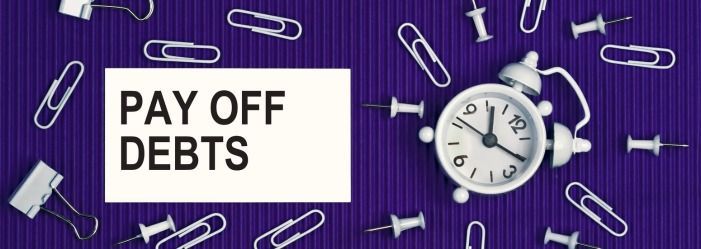Last Updated: March 14, 2024
Strategies and Tips for Accelerating Credit Card Debt Payoff

Disclaimer: We are not qualified legal or tax professionals and are not giving advice. Always speak with a qualified professional before making any legal or financial decisions.
Facing credit card debt can feel overwhelming, but with a structured approach, it's surprisingly manageable.
This post will guide you through effective strategies, from prioritizing high-interest debt to exploring consolidation options, to help you break free from credit card debt faster and more efficiently.
Let's embark on this journey to financial freedom together, equipped with practical steps and insights. By the end, you'll have a clear plan of action to tackle your debt and pave the way toward a more secure financial future.
Want to skip the article and speak directly to a debt specialist? Click here for a free consultation
Individual Debt Pay Down
This method involves paying off each debt in a specific order. There are two different philosophies, the snowball and the avalanche method. Your first step is to list all your debts, the interest rate on each and the amount owed.
Credit card 1
- Balance $500
- interest rate 16%
- minimum payment $50
Credit card 2
- Balance $1000
- Interest rate 21%
- Minimum payment $100
Minimum Payments: If you pay off credit card 1 at the minimum payment, it will take you 11 months and you’ll pay $40.20 in interest. Paying off credit card 2 will take 12 months and you will be charged $108.86 in interest. You will pay a total of $149 in interest.
The Snowball method: Order your debts from lowest amount to highest amount. Pay off the lowest amount first. Then apply that amount to the next lowest bill. For instance:
If you pay off credit card 1 at the minimum payment, it will take you 11 months and you’ll pay $40.20 in interest. Paying off credit card 2 will take 12 months and you will be charged $108.86 in interest. You will pay a total of $149.00 in interest.
If you use the snowball method and pay off credit card 1 by paying $100 each month, you will pay off credit card 1 in 6 months and pay $20.89 in interest charges. That about half the time and the amount of the minimum payment method.
You now turn your attention to credit card #2. You have made six months of minimum payments, leaving you with a balance of roughly $518.00. You apply the amount you have been using for credit card 1 ($100) and the minimum amount due ($100) to pay $200 each month. You will pay off credit card 2 in 3 months and pay $20.09 in interest charges.
You are debt free in 9 months. You have paid a total of $123.83 in interest.
The Avalanche method: Order your debts from highest interest rate to lowest. Focus on paying off the highest interest card first.
If you use the avalanche method and pay off credit card 2 by paying $150 each month, you will pay off credit card 2 in 8 months and pay $72.59 in interest charges. You now turn your attention to credit card 1. Your balance is roughly $136.00. You make one payment of roughly $138 (including interest and any residual fees) and you are finished!
You are debt free in 9 months. You paid a total of $110.00.
In this instance, the biggest difference is psychological. By paying off the smaller debt first, you may feel more achievement and it may make it easier for you to keep up the plan. However, it is up to you!
If you’d like to try out these two methods on your own debts, try our
credit card interest rate calculator.
Debt Consolidation
This method involves rolling all your debt into a single loan or balance transfer credit card and paying it off at once. You then have to pay off your consolidation loan or balance transfer.
The Consolidation Loan: Using the same examples that we used above, let’s see how getting a single loan affects your debt. The first barrier will be getting a personal loan. The better your credit score, the better your interest rate will be. If you have a fair or poor credit score, you may need to focus on improving your credit score first.
You can find a loan through a credit union or bank for $1500 and an interest rate of about 15%. It will take you 11 months to pay off the loan by paying the $150 you are already paying. You will pay about $113 in interest. Your terms will determine how long and how much. Remember that you can always pay off a loan faster - the terms for this loan were 3 years and $52 a month. Since the goal is to be debt-free, we chose to pay $150.
The Balance Transfer Method: This involves finding a 0% APR balance transfer card. You roll all $1500 onto the balance transfer card. If you’re paying $150 a month, it will take 10 months to pay off the balance and you will pay no interest. Learn more about this technique in
a guide for zero percent APR balance transfers to pay off credit cards.
One huge warning! There are fees for rolling the balance and the normal interest rate after the introductory period may be significantly higher than you are paying now.
| Length | Total paid | Total interest | |
|---|---|---|---|
| Minimum payment | 12 months | $1750 | $149 |
| Snowball | 9 months | $1600 | $124 |
| Avalanche | 9 months | $1338 | $110 |
| Debt consolidation | 11 months | $1613 | $113 |
| Balance transfer | 10 months | $1500 | $0 |
Debt Settlement
If you have more debt than you can pay off and are barely about to make the minimum payments, you may need professional help. The next option is debt settlement. With this option, you, or your representatives, negotiate with your debtors to decrease the amount you owe. This takes time, and may have temporary negative effects on your credit score.
Budgeting to Pay Down Debt
Getting your spending under control is a critical first step before tackling debt paydown. Creating a detailed budget allows you to see exactly where your money is going each month, and highlights areas where you may be able to cut expenses. Here are some budgeting strategies that can help free up more cash to put toward debt:
Use a budgeting app
Apps like Mint make budgeting super simple by automatically categorizing your spending and sending alerts if you go over budget in certain areas. Mint also offers bill pay features and can be linked directly to your bank accounts.
Look for non-essential expenses to cut
Go through recent credit card and bank statements line by line. Dining out, entertainment, memberships, and subscriptions are common areas where expenses can be reduced. Even small daily spending cuts like bringing lunch from home or dropping a premium cable package can really add up.
Set up automatic payments
Having fixed payments automatically debited from your checking account avoids late fees and ensures debts get priority. Just be sure the payment amount is an amount you can afford based on your budget.
Use Budget Calculator tools
The Budget Calculator and Debt Calculator allow you to model different payment scenarios to find the right debt paydown tempo for your unique situation.
Debt Consolidation Strategies
If high-interest credit card debt is proving difficult to pay off, consolidating debts into a single lower-rate loan may help accelerate payoff.
Balance Transfers
Moving debt to a 0% APR balance transfer credit card can save substantially on interest. Many cards offer 0% intro APR periods of 12-18 months. Be mindful of balance transfer fees, typically 3-5% of the amount moved. Use our Balance Transfer Calculator to model scenarios.
Personal Loans
Banks and credit unions provide fixed-rate personal loans that can be used to consolidate credit card balances. The best rates go to borrowers with good/excellent credit. Our Loan Calculator can help find affordable loan terms.
Home Equity Loans
Homeowners with available equity can tap home value via a second mortgage or home equity line of credit (HELOC). These may offer lower interest rates but often have high closing costs. Risks include losing your home if unable to repay.
When Debt Settlement Makes Sense
If debts are becoming truly unmanageable, reaching out to creditors directly to negotiate reduced settlements may be an option. This is commonly done through debt settlement companies.
Contact creditors early
Don't wait until severely behind on payments. Creditors are more likely to offer relief programs to borrowers acting in good faith with regular communication.
Get terms in writing
Any verbal agreements mean little. Make sure any settlement offers, hardship arrangements, or other relief plans are provided in official letters.
Be realistic
Creditors typically require a lump-sum payment that is less than the full balance. Know what you can afford before making settlement offers.
Review our Debt Settlement Guide
For more details on this process see our Guide to Debt Settlement. Our experts can also discuss if this option is right for your situation.
FAQs
Conclusion
Getting out of credit card debt may seem daunting, but is achievable with the right strategy and discipline. The first critical steps are to stop additional spending on cards and construct an airtight budget that directs maximum funds toward paying balances down.
Mathematical payoff methods like the debt avalanche and snowball can then accelerate progress. Those with excellent credit may benefit from consolidating multiple high-interest balances into a 0% balance transfer card or fixed-rate personal loan. Consolidation combines debts for simplified tracking while lowering interest costs.
On the flip side, should debts become unmanageable, exploring hardship programs or negotiated settlements with issuers provides options too. Additionally, consider exploring
side hustles that can help pay off your debt faster.
With various tactics available, consumers in different financial circumstances can find a path forward. The key is sticking to a debt reduction plan until the victorious day when balances reach zero.
We invite you to schedule a free consultation with us to discuss which combination of paydown and relief solutions could liberate you from balances for good.
Pacific Debt, Inc
Pacific Debt, Inc. is an award-winning debt settlement company. If you’d like more information on how to get out of debt, we are happy to help. We will explain all your options and help you decide which is the best option for you. We can even refer you to trusted partners who can better meet your needs.
If you have more questions, contact one of our
debt specialists today. The initial consultation is free, and our debt experts will explain your options to you.
*Disclaimer: Pacific Debt Relief explicitly states that it is not a credit repair organization, and its program does not aim to improve individuals' credit scores. The information provided here is intended solely for educational purposes, aiding consumers in making informed decisions regarding credit and debt matters. The content herein does not constitute legal or financial advice. Pacific Debt Relief strongly advises individuals to seek the counsel of qualified professionals before undertaking any legal or financial actions.
✔ Accredited by Better Business Bureau with BBB A+ rating (4.93 rating and 1678 reviews)
✔ US News and World Reports and Bankrate ranked Pacific Debt Relief as one of “The Best Debt Relief Companies of 2024”
✔ 6.9 star rating by BestCompany.com (over 2379 client reviews)
✔ 4.8 star rating by TrustPilot based (over 1613 verified consumer reviews)
✔ ConsumerAffairs.com Accredited (over 544 verified reviews with an average rating of 5 stars)
✔ A Top 10 Rated Compan by TopTenReviews.com , ConsumersAdvocate.com and Top10debtconsolidation.com
✔ 4.6 star rating by Google (229 client reviews)
✔ 100% rating by SuperMoney (9 client reviews)
Reduce Your Credit Card Debt By Up to Half

BBB Reviews | 4.9/5.0 Rating









 Do Not Sell My Personal Information
Do Not Sell My Personal Information